The free-living stony coral Heliofungia actiniformis is one of the largest solitary polyp corals, and it has been popular with reef keeping aquarists since the early days of the reef aquarium hobby. The appearance of the living animal is very deceptive to the first time observer. Most who see it at first think it is a sea anemone, and this is the reason for its specific name. The polyp of Heliofungia has the ability to swell dramatically with water, a feature that enables it literally to walk across the substrate, or turn itself back over if it is overturned. This feature also enables the coral to escape from being buried by sediment that may settle on it during stormy weather conditions, and it allows the coral to live and remain on top of soft bottom habitats where other corals would simply sink into the mud and suffocate (Hoeksema,1988).
Based on the form of the skeleton, Heliofungia has always been considered to be related to other fungiid corals, such as Fungia, Ctenactis and Herpolitha. In fact it was originally described as Fungia actiniformis. The new genus was created on the basis of the very different polyp form, compared to other fungiids. Heliofungia actiniformis is the only species in its genus, though regional variations have been described.
Heliofungia is common in the Indo-Pacific region, occurring on reef slopes and especially in lagoon reef habitats, in shallow and in deep water. There are regional differences in the diameter of the tentacles, and some specimens develop bifurcated tentacle tips. Abe (1940) discusses growth variation and environmental conditions that may affect the form of this coral. Several color forms exist, but no one has correlated habitat with color form. It is most likely that there is no such connection and the color forms are merely an expression of genetic variation, such as hair color or eye color in humans. The most common color form is brownish gray with pale stripes on the oral surface and white tips on the tentacles. Another common form is fluorescent green with a striped oral surface and white tentacle tips. The most spectacular forms have bright pink tentacle tips. These may have a brown, gray or fluorescent green background as well. The green and pink combination is quite similar to the popular coral Catalaphyllia jardinei. The brown with white tipped tentacles and green with white tipped tentacles are easily confused with the coral Euphyllia glabrescens. It is my opinion that this similarity is not merely a matter of convergence. The similarity to Euphyllia glabrescens goes beyond mere coloration, but I will elaborate on that in a moment. There does seem to be at least one case of convergence or mimicry involved in the form and color of Heliofungia polyps. The brown form with white tipped tentacles strongly resembles a color form of the sea anemone Heteractis magnifica. If this resemblance is a form of mimicry, the explanation for it is not entirely clear. While the anemone Heteractis magnifica has a potent sting that makes fish avoid it, butterflyfishes may attack and eat an anemone if it is not guarded by a pair of clownfish that aggressively defend their host. Since Heliofungia does not harbor clownfishes, the coloration might seem like an invitation to be attacked by butterflyfishes. This does not seem to be a problem for the coral in its natural habitat, so it is likely that the corals own sting is effective at discouraging predators. In aquariums, however, butterflyfishes will eat Heliofungia, possibly an artifact of reduction in stinging by the coral when it is not in perfect condition.

Note some exsert septa on the skeleton of this Euphyllia glabrescens. It is not difficult to imagine the evolution of free-living polyps that look like fungiids.
Regarding the similarity between Heliofungia actiniformis and Euphyllia glabrescens, I have discussed my opinions previously (Sprung, 1999a and b). I originally came to believe that Heliofungia was more closely related to Euphyllia spp. than Fungia spp. on the basis of the manner in which it often dies and its asexual means of reproduction (Sprung, 1999b). Heliofungia often succumbs to protozoan infections ( Helicostoma nonatum ) that produce “brown jelly” with necrotic tissue, exactly the kind of infections that affect Euphyllia spp. In Euphyllia these infections can be stopped with a simple freshwater bath followed by careful siphoning off of the necrotic tissue. Euphyllia colonies are composed of series of polyps or separate polyps in phacelloid colonies. If they get an infection it is possible to sever the affected area and save the colony. The result is the loss of one or more polyps (or regions with an oral center) in a colony, but the rest of the colony can be saved. In Heliofungia the “colony” cannot be saved because it is a single polyp. Infections in Heliofungia are almost always fatal. Herein lies a difference with Fungia spp. Fungia spp. are also single polyps, but they can survive loss of some or even most of their tissue mass. In such situations Fungiid corals commonly develop polyp buds called anthocauli on their oral surface, and these buds develop into new fungiid corals that grow and detach from the original “mother” polyp’s skeleton. This mode of reproduction may be possible for Heliofungia under the right conditions, as it is known for many genera of corals, but I have not personally seen it in Heliofungia in an aquarium or in the natural habitat. By contrast, the formation of anthocauli in Fungia spp. is ubiquitous in the wild and in aquaria. Heliofungia actiniformis does form polyp buds, but these are located on the underside of the skeleton, not on the oral surface. This is analogous to the formation of daughter colony buds beneath the polyps in Euphyllia spp.
The assertion that Heliofungia is closely related to Euphyllia is supported further if one looks at the appearance of newly settled polyps of Heliofungia compared to newly settled polyps of Euphyllia glabrescens. They are practically indistinguishable. Both are attached to the substrate. In Heliofungia the polyps break from their attachment point when they reach a certain size, which is the same mode of development that fungiid corals have. It is my opinion that Heliofungia has adapted this mode and the free-living lifestyle to take advantage of habitats where a sessile coral would likely be buried. The physical requirements of such a lifestyle promote development of its shape. Thus I am suggesting that the similarity between the shape of the skeleton of Fungia and Heliofungia is a more a matter of convergence than close relationship. If one compares the density of the skeleton in Heliofungia to fungiids and Euphyllia spp., one finds that the density of the Heliofungia skeleton is more like Euphyllia. The shape of septal and costal teeth on Heliofungia is more like Fungiids, but this might be explained by the physical requirements of a free-living coral of this shape; see for example Hoeksema, (1993). The aforementioned trait of developing bifurcated tentacle tips seems to be another connection to Euphyllia. Note the photographed specimen, which looks like Euphyllia divisa.
Given the choice of revising its taxonomy, one could place Heliofungia in the same genus as Euphyllia. Alternatively it could retain its name and be moved to the family that contains Euphyllia, the recently created family Euphyllidae (Veron, 2001). The latter option seems appropriate to me, if my hypothesis is correct.
As a side note, while I’m discussing taxonomical revisions in the family Euphyllidae, there is another popular reef aquarium coral that I believe is related to Heliofungia and Euphyllia, though its present taxonomy suggests otherwise to the extreme. The coral Galaxea is presently classified with Oculina in the family Oculinidae. Galaxea has absolutely nothing in common with Oculina, a coral that has a dense skeleton and polyp structure clearly like Solenastrea, Astrangia, and the fossil coral Septastrea. The coral Physogyra, which belongs to the Euphyllidae, has a similar skeletal structure to Galaxea, though the polyps in Physogyra are meandroid. The calyces of Physogyra lichtensteini are embedded in a very porous skeletal matrix called coenosteum, as are the calyces in most Galaxea, except for G. (=_Acrhelia_ ) horrescens, The living polyps of Galaxea bear no resemblance to those of Oculina, but are very much like tiny Euphyllia glabrescens. See the photo of them side by side for comparison. Looks can be deceiving, so this similarity does not necessarily mean they are closely related as I am suggesting. I hope to have the opportunity to test this hypothesis some day. The similarity goes beyond looks. Anyone who has kept Galaxea is familiar with its stinging abilities and the formation of very long sweeper tentacles. These traits are found in Euphyllia spp., but not in Oculina.
Husbandry requirements for Heliofungia
Keeping Heliofungia in a reef aquarium is not difficult. One should of course avoid fishes that may pester or feed on the coral. Various angelfish and butterflyfishes fall in this category. The aquarium should have a sufficiently large flat horizontal area on the bottom where the coral can be placed, on gravel, sand, or rock. The coral thus will be correctly oriented with respect to the light, and will have sufficient room to move around. There should be no other corals, soft or hard, that the Heliofungia might contact as it moves around on the bottom. An exception is that there can be other Heliofungia. Heliofungia normally grows and thrives in captivity, but as I previously described, it is prone to infections. If the coral develops a brown jelly infection it is important to remove it from the aquarium. The fouling tissue from a dying Heliofungia may spread the infection to other corals, killing them in an effect like falling dominoes (Delbeek and Sprung, 1994).
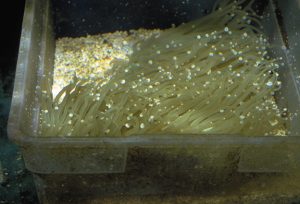
This Heliofungia actiniformis has bifurcated tentacle tips that make it strongly resemble Euphyllia divisa.
Lighting
Heliofungia is not very demanding with regard to illumination. It can be kept under standard output fluorescent lights as easily as under high output tubes or metal halide lamps. If it has room to move around, it will choose a location where the lighting is best.
Water motion
Heliofungia does not like very strong water currents. Under strong flow it will not expand fully. It will expand beautifully under slight to moderate water flow that gently moves the tentacles. This movement promotes gas exchange and assures uniform illumination of the whole polyp.
Temperature
While Heliofungia tolerates fairly hot water conditions in the natural environment (to at least 87 degrees Fahrenheit), I recommend maintaining it at much cooler temperatures in the aquarium. This is mainly because infections are less common at cooler temperatures, in my experience. An ideal temperature is about 75 degrees Fahrenheit.
Feeding
It is not necessary to feed Heliofungia directly in a well-illuminated aquarium that has a typical fish population. The fish food and feces as well as dissolved nitrogenous waste supply enough nutrition for the coral to thrive, apart from the nutrition Heliofungia obtains from its symbiotic zooxanthellae. Heliofungia does eat solid food, and the occasional small piece of chopped fish, shrimp, crab, or clam meat will be eagerly consumed.
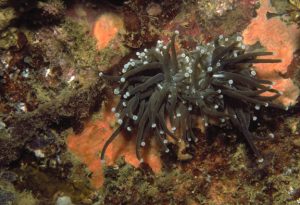
Three young Heliofungia polyps here attached to a shipwreck. Compare their appearance to Euphyllia glabrescens.
Calcium and Alkalinity
As with all stony corals, the growth of the calcareous skeleton requires the maintenance of calcium and alkalinity levels in the water. The calcium level should be between 350 and 500 ppm and the alkalinity between 2.5 and 4-meq/l.
Trace Elements
Supplementation with iron and manganese may be needed to promote the health of the zooxanthellae in closed system aquariums and to prevent bleaching responses in brightly illuminated corals (Sprung, 2002). The addition of strontium may be beneficial for the skeletal growth of Heliofungia, but that has not been tested.
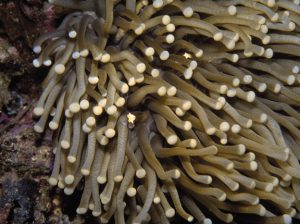
Periclimenes spp. shrimps often live in association with Heliofungia. This relationship can be maintained in an aquarium.
Reproduction
While other fungiid corals readily fragment to effect asexual reproduction, fragmentation in Heliofungia is a rare occurrence in nature, and is not employed significantly as a means of asexual reproduction. It is possible to sever a polyp successfully to produce clones, but the survival of the severed pieces is low compared to other fungiids. As mentioned previously, Heliofungia forms polyp buds on the underside of the disc, and these can be severed to produce asexual offspring.
Sexual reproduction in Heliofungia may involve different modes depending on the population. Some populations appear to be hermaphroditic brooders, while others have distinct sexes that spawn at the time of mass coral spawns (Delbeek and Sprung, 1994).
Commensals
Heliofungia commonly harbors commensal organisms, and these relationships, while not essential to the coral, offer unique opportunities for a display aquarium. Various shrimps of the genus Periclimenes associate with this coral, and a very special tiny white pipefish, Siokunichthys nigrolineatus is associated with it in some regions. Although clownfishes do not associate with Heliofungia in the wild, in aquariums they may do so. If the clownfish are large and very active, they may disturb or injure the Heliofungia.
References And Suggested Reading
- Abe, N. 1940. Growth of Fungia actiniformis var. palawensis DÖDERLEIN and its environmental conditions. Palao Trop. Biol. Sta. Stud., 5: 105-145, 11 figs., 16 tabls.; Tokyo.
- Delbeek and Sprung, 1994. The Reef Aquarium Volume One. Ricordea Publishing, Coconut Grove, FL.
- Hoeksema, B.W. 1993. Phenotypic corallum variability in Recent mobile reef corals. Cour. Forsch.-Inst. Senckenberg, 164: 263-272, 4 figs., 3 tabls.; Frankfurt am Main.
- Hoeksema, B.W. 1991. Evolution of body size in mushroom corals (Scleractinia: Fungiidae) and its ecomorphological consequences. Netherlands Journal of Zoology 41 (2-3):112-129
- Hoeksema, B.W. 1989. Taxonomy, phylogeny, and biogeography of mushroom corals (Scleractinia: Fungiidae). Zool. Verh. Leiden 254: 1-295.
- Hoeksema, B.W. 1988. Mobility of free-living Fungiid corals (scleractinia), a dispersion mechanism and survival strategy in dynamic reef habitats. in: Proceedings of the 6th International Coral Reef Symposium, Australia, 1988, Vol 2
- Sprung, J. 2002. Captive husbandry of Goniopora, spp. with remarks about the similar genus Alveopora. Advanced Aquarist Online.
- Sprung, J. 1999. Corals: A Quick Reference Guide. Ricordea Publishing. Coconut Grove Florida.
- Sprung, J. 1999b Is there really something special about Goniopora, Alveopora and Heliofungia?” Marine Fish and Reef USA .
- Veron, JEN. 2001. Corals of the world. AIMS. Townsville, Australia.
- Wells, J. W. 1966. Evolutionary development in the scleractinian family Fungiidae. Pp. 223-246 in Rees, W.J. (ed.), The Cnidaria and their evolution. Symposia of the Zoological Society of London, No. 16, 449pp. Academic Press, London, New York.


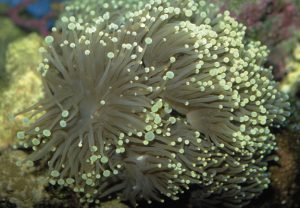
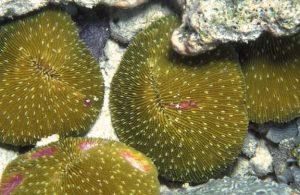

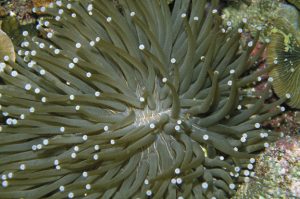


0 Comments